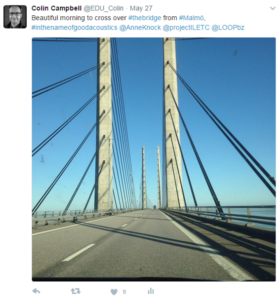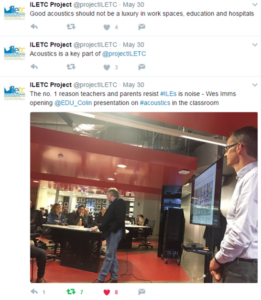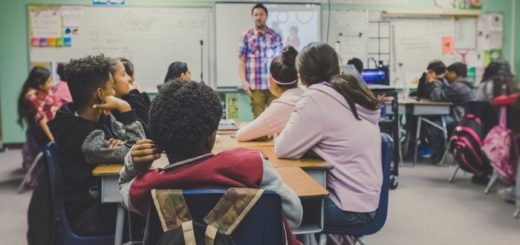I can’t hear myself think – lessons learned in Melbourne!

In this guest post by one of our research partners, Colin Campbell, Central Concept Developer – Educational Environments, at Ecophon in Sweden, read about the importance of designing learning spaces with acoustics that match their intended use…
I travelled over from Sweden to attend the recent ILETC project partners meeting and the excellent Transitions Symposium “Inhabiting Innovative Learning Environments” . Focusing on crossing over with ILETC project researchers, industry partners and other interested parties, I also presented at an informal lunchtime seminar on acoustics in the classroom.
As well as covering the importance of good acoustics in classrooms referencing various studies, I covered pedagogic changes around innovative learning environments involving changes from traditional teacher-led to student centered learning activities and the many associated issues around this. I highlighted the need to provide acoustic conditions which control of sound levels, speech intelligibility, speech privacy between spaces and control of indoor ambient noise. I also featured some European interesting case study examples from my EDUnet colleagues and covered the practicalities of these evolving pedagogic approaches and spaces. The need for activity based acoustic design in planning towards potential innovative learning landscapes to support sustainable learning outcomes, health and well-being. The main points of my presentation are available here.
To make the presentation available at short notice it was suggested we should use one of the informal teaching spaces in the University. A lecture theatre was also booked as back up as it was unclear how many people would attend at short notice. Around 20 people attended—a mix of academics, architects and acousticians—and in the spirit of taking learning to informal teaching spaces, we (started) in the main multi- purpose social space access by all students. An obvious challenge but nothing I could not accept if only to put it down to a learning experience.
Wes Imms, the Chief investigator of the ILETC project introduced me and very early on I realized I had many activities not only competing for the audience’s attention but also creating a background noise level that made it hard for me to be heard and hard for me to hear myself. There was a café directly opposite me, students having lunch and talking and students circulating all around me. I had to raise my voice to a shouting level but still life carried on around us.
After 20 minutes, Wes decided to intervene and with everyone’s agreement we moved up to the lecture theatre which had also been booked. The transformation was incredible. I was able to continue in a much more suitable setting and the lesson, apart from my acoustic message was that “flexible spaces” which are intended for many different types of activities often are completely unsuitable and therefore not used – as was the case on this occasion. Anyway, we managed to have questions and a great broader discussion in the lecture theatre and I am sure the attendees will not forget the experience. I think we all gained a lot from the exercise – I certainly will not forget the experience and how uncomfortable the space was when trying to reach out to many people in a “flexible space”.

So I hope in the future you don’t fail like I did and find yourself also realising “I can’t hear myself think!” – If you do though, please remember that good acoustics is not a luxury, it is a commodity we should expect if we are to support good speech communication.
If you have any specific questions about any of the above research or case studies please email me colin.campbell@ecophon.se Twitter: @EDU_Colin
Otherwise, further info around my presentation; films, downloads etc. can be found with the following links:
- Educational Environments at Acoustic Bulletin
- Bremen Study: Acoustic Ergonomics of schools Short summary
- Essex Study: Full Study Report and short summary
- Essex Study rooms balloon pops
- Witzenhausen: Film and acoustic report
- DeWerkplaats: film and school testimonials
- Other testimonial articles from schools regarding acoustics



